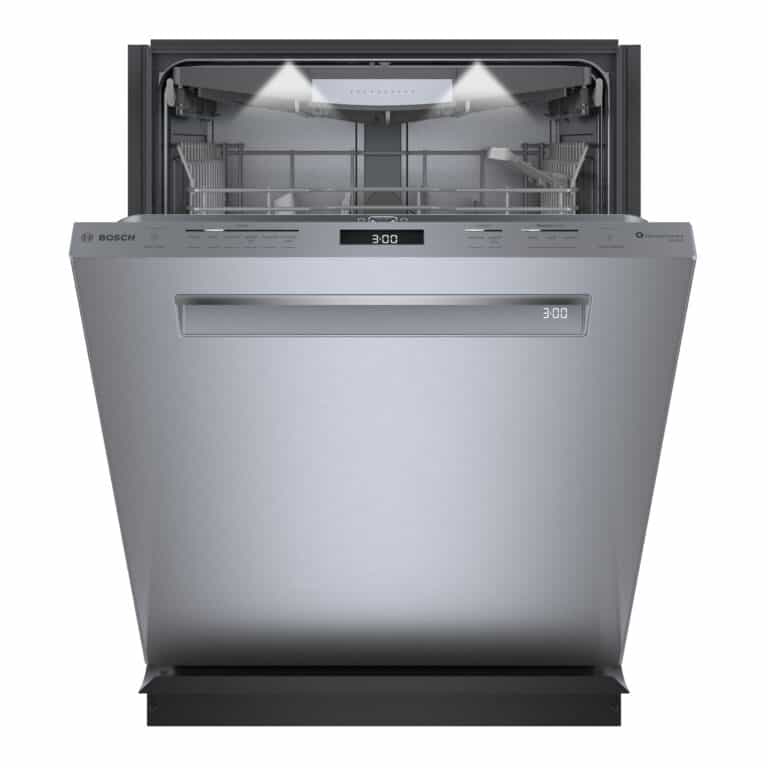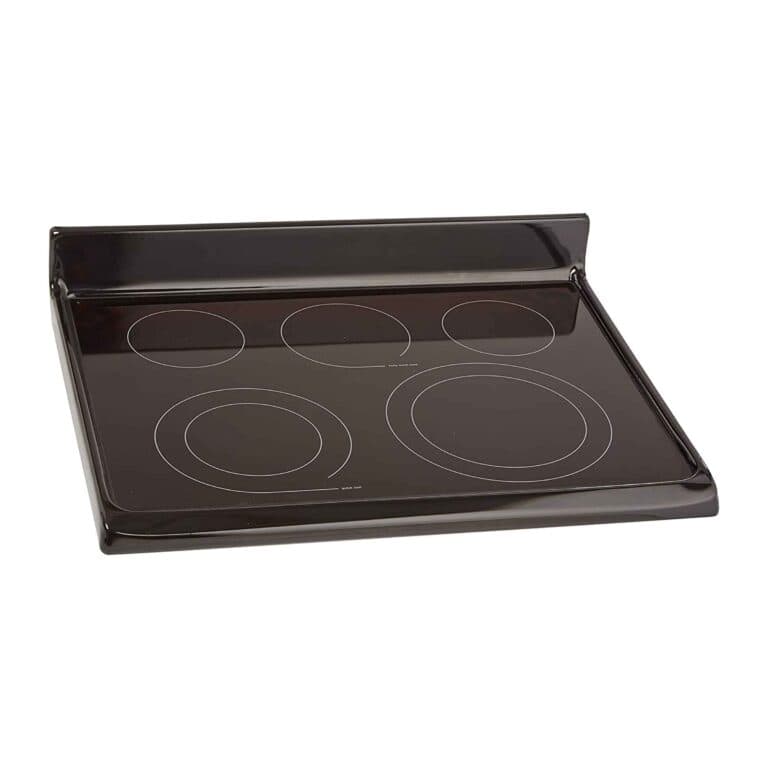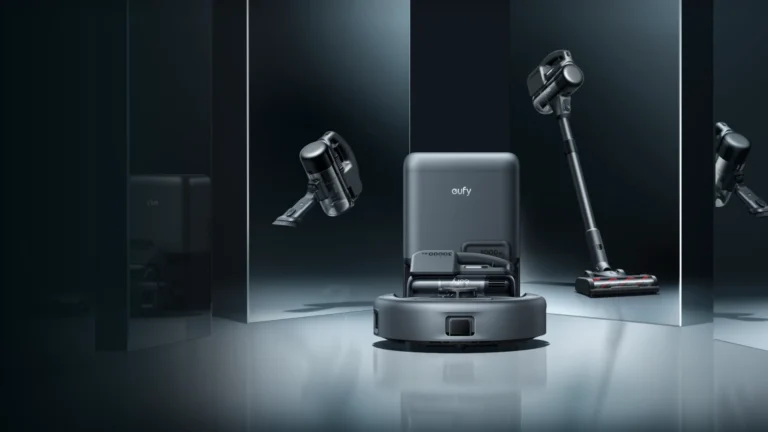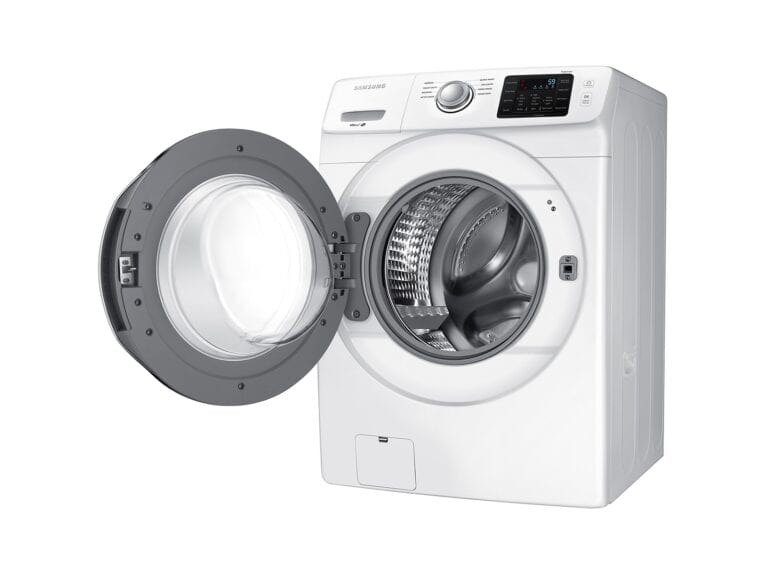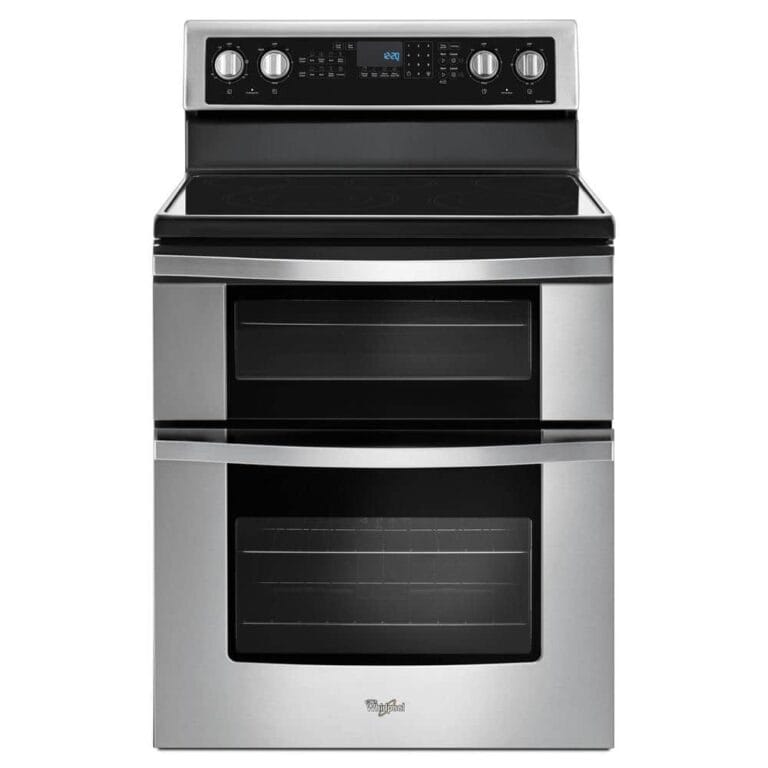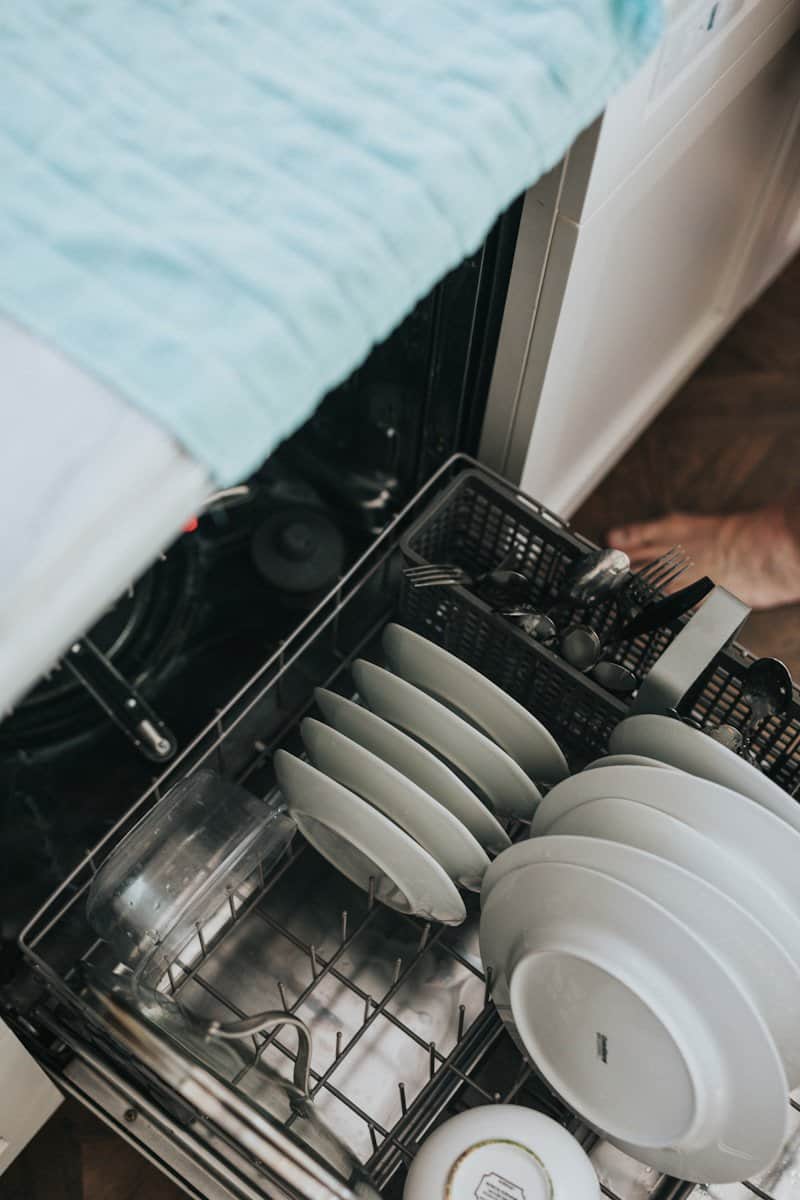
The E4 error on a dishwasher usually indicates an issue with water filling or an overflow. This is a common problem that can often be troubleshooted on your own and doesn’t need professional repair. The specifics may vary by brand, but the general causes and troubleshooting steps are similar.
Possible Causes of an E4 Error:
- Overfilling: The dishwasher has taken in too much water. This could be due to a faulty water inlet valve that isn’t shutting off properly.
- Leakage: There’s a leak somewhere in the dishwasher, causing water to accumulate in the base pan or trigger a float switch.
- Float Switch Issues: The float switch, designed to detect rising water levels and prevent overflows, might be stuck, malfunctioning, or misaligned.
- Drainage Problems: A blockage in the drain hose, drain pump, or filters can cause water to back up and trigger the E4 error.
- Faulty Water Inlet Valve: This valve controls the flow of water into the dishwasher. If it’s malfunctioning, it might not close properly, leading to overfilling.
- Pressure Switch Issues: Some dishwashers use a pressure switch to monitor water levels. A faulty switch can send incorrect signals, leading to an E4 error.
Troubleshooting Steps:
- Check for Leaks: Inspect the dishwasher for any signs of leaks, especially around the door seal, hoses, and connections.
- Check the Float Switch: Locate the float switch (usually a small plastic piece that floats up with rising water) and make sure it’s not stuck or obstructed.
- Inspect the Drain Hose and Filter: Check the drain hose for kinks or blockages. Clean the drain filter and make sure it’s properly installed.
- Check the Water Inlet Valve: Ensure the valve is properly connected and that there are no visible signs of damage.
- Check the Water Supply: Make sure the water supply valve to the dishwasher is fully open and that there are no kinks in the water supply hose.
- Reset the Dishwasher: Try turning off the dishwasher, waiting a few minutes, and then turning it back on. This can sometimes reset the error code.
Important Notes:
Consult Your Dishwasher’s Manual: The specific meaning of the E4 error code and troubleshooting steps may vary slightly depending on your dishwasher’s brand and model. Always refer to your user manual for detailed instructions.
Safety First: Before performing any troubleshooting steps, disconnect the dishwasher from the power supply to avoid electric shock.
Troubleshooting the E4 Dishwasher Error
The E4 error typically indicates that your dishwasher is having trouble filling with water within a specific timeframe. This could be due to several reasons:
1. Water Supply Issues
- Check the water supply valve: Make sure the valve supplying water to your dishwasher is fully open. It’s usually located under the sink.
- Check for kinks in the water supply hose: A kinked hose can restrict water flow. Inspect the hose for any bends or kinks and straighten them out.
- Check your home’s water pressure: Low water pressure can prevent the dishwasher from filling properly. You can check this by observing the water flow from other faucets in your home.
- Check for water supply interruptions: Sometimes, there might be temporary water outages in your area. Check with your local water supplier.
2. Inlet Valve Problems
- Clogged inlet valve: The inlet valve controls the flow of water into the dishwasher. If it’s clogged with debris, it can restrict water flow. You might need to clean or replace the inlet valve.
- Faulty inlet valve: The inlet valve might be malfunctioning. If it’s not opening properly, water won’t be able to enter the dishwasher. You might need to replace the inlet valve.
3. Float Switch Issues
- Stuck float switch: The float switch is a safety mechanism that prevents the dishwasher from overfilling. If it’s stuck in the “up” position, it can signal to the dishwasher that it’s already full, preventing it from filling. Check the float switch and make sure it moves freely.
- Faulty float switch: The float switch might be faulty and needs replacement.
4. Other Potential Issues
- Control board problems: In some cases, the control board that governs the dishwasher’s functions might be faulty.
- Wiring problems: There might be loose or damaged wiring connections related to the water inlet system.
Troubleshooting Steps
- Turn off the power: Disconnect the dishwasher from the power supply by unplugging it or turning off the circuit breaker.
- Check the water supply: Inspect the water supply valve, hose, and water pressure as described above.
- Inspect the inlet valve: If you’re comfortable doing so, you can check the inlet valve for clogs or damage. You might need to consult your dishwasher’s manual for instructions on how to access it.
- Check the float switch: Locate the float switch (usually in the bottom of the dishwasher) and make sure it moves freely.
- Reset the dishwasher: After checking the above, try resetting the dishwasher by turning off the power for a few minutes and then turning it back on.
Dishwasher Maintenance Tips
Regular maintenance can help prevent dishwasher errors and keep your appliance running smoothly:
- Clean the filter regularly: Remove and clean the filter at the bottom of the dishwasher to prevent clogs.
- Run a cleaning cycle: Use a dishwasher cleaner monthly to remove buildup and keep the interior clean.
- Don’t overload the dishwasher: Overloading can impede proper water circulation and cleaning.
- Scrape food scraps before loading: Remove large food particles to prevent clogs in the filter and spray arms.
- Inspect the spray arms: Make sure the spray arms are not clogged and can rotate freely.
- Check for leaks: Regularly inspect for any signs of leaks and address them promptly.
By following these tips, you can help prolong the life of your dishwasher and avoid those frustrating error codes!
Understanding the E4 Error Code
The E4 error code on a dishwasher typically indicates issues with water supply or drainage. This error can stem from various causes and involves several key components.
Common Causes of E4 Error
Blockages in the drainage system often trigger the E4 error. These can occur in the drain hose, filters, or pump. Kinked or damaged hoses may also cause this issue. Sometimes, a faulty water inlet valve prevents proper water flow into the dishwasher. Malfunctioning float switches can incorrectly signal water levels, leading to E4 errors. In some cases, problems with the temperature sensor may cause the dishwasher to misread water temperatures and display this error.
Components Associated With E4 Error
The drain hose plays a crucial role in water removal. It should be free of clogs and kinks. The float switch monitors water levels and can stick due to debris. The water inlet valve controls water flow into the machine. Its fine mesh screen may become clogged. The temperature sensor ensures proper water heating. Filters trap food particles and prevent drain blockages. The drain pump moves water out of the dishwasher. Any of these components can contribute to an E4 error if they malfunction or become obstructed.
Troubleshooting Steps for E4 Error
The E4 error on dishwashers typically indicates issues with water supply, blockages, or drainage problems. Addressing these areas systematically can often resolve the error.
Checking the Water Supply
Start by examining the water supply to the dishwasher. Ensure the water valve is fully open. Check the water inlet hose for kinks or twists that might restrict flow.
Inspect the water inlet valve screen for debris. Clean it if necessary. A clogged screen can limit water entering the dishwasher.
Test the water pressure. Low pressure can trigger the E4 error. Run hot water from a nearby faucet to verify adequate pressure and temperature.
If issues persist, consider replacing the water inlet valve. This component controls water flow into the appliance and can malfunction over time.
Inspecting and Cleaning Blockages
Blockages in the dishwasher can cause drainage issues, leading to the E4 error. Remove the bottom rack and check for food particles or debris in the sump area.
Clean the dishwasher filter. It’s usually located at the bottom of the tub. Rinse it under running water to remove accumulated grime.
Examine the spray arms for clogs. Remove them and clear any obstructions from the spray holes. This ensures proper water distribution during cycles.
Check the air gap if your dishwasher has one. It’s typically mounted on the sink or countertop. Clean out any debris that might be blocking it.
Assessing Drainage System
Inspect the drain hose for kinks or bends. Straighten any found to allow smooth water flow. Ensure the hose isn’t pinched behind the dishwasher.
Check if the drain hose is properly connected to the sink drain or garbage disposal. A loose connection can cause drainage problems.
Clear any clogs in the sink drain or garbage disposal. These can prevent water from draining properly, triggering the E4 error.
Verify the drain pump’s functionality. Listen for unusual noises during the drain cycle. A faulty pump may need replacement.
If these steps don’t resolve the issue, consider calling a professional technician. They can perform more in-depth diagnostics and repairs.
When to Seek Professional Help
Persistent E4 errors require expert intervention. If basic troubleshooting steps fail, it’s time to call a technician. This is especially true for Whirlpool dishwashers, known for their complex systems.
Repeated error codes signal underlying issues. A professional can diagnose and fix problems beyond simple clogs or switches. They have specialized tools and knowledge to tackle electrical or mechanical failures.
Safety is paramount. DIY repairs can be dangerous, particularly with water and electricity involved. Certified technicians ensure safe and proper repairs.
Warranty considerations are important. Attempting repairs yourself may void the warranty. Professional service keeps your coverage intact.
Time and frustration are factors. A technician can often resolve issues quickly, saving you hours of trial and error. They can also prevent future problems through proper maintenance.
Signs it’s time for professional help:
- Error persists after basic troubleshooting
- Multiple error codes appear
- Unusual noises or leaks
- Incomplete wash cycles
- Electrical issues
Costs vary, but professional repairs are often more cost-effective long-term. They prevent repeated breakdowns and extend your dishwasher’s lifespan.
Frequently Asked Questions
The E4 error on dishwashers can be frustrating, but there are several steps to resolve it. Different brands may have specific troubleshooting methods, so it’s important to know how to address this error for various dishwasher models.
What are the steps to resolve an E4 error on a dishwasher?
To fix an E4 error, start by checking the drain hose for blockages or kinks. Remove any obstructions and straighten the hose if needed. Next, clean the filters thoroughly to ensure proper water flow. Inspect the float switch and gently lift it to see if it moves freely. Clean away any debris that may be obstructing its movement.
Check the drain pump for any food particles or debris. Remove the pump cover and clean the impeller thoroughly. Lastly, examine the water inlet valve and clean its fine mesh screen if necessary.
Can an E4 error code be reset on a Kenwood dishwasher?
Kenwood dishwashers typically allow users to reset the E4 error code. To do this, unplug the dishwasher from the power source for about 5 minutes. This action often clears the error code. After plugging it back in, run a test cycle to see if the error persists.
If the error continues, check the drain hose and filters for blockages. Clean them thoroughly before attempting another cycle.
What does an E4 error signify on a Bosch dishwasher?
On a Bosch dishwasher, an E4 error usually indicates a problem with the water supply or drainage system. It may mean that the dishwasher is not filling with water properly or is having trouble draining.
Check the water inlet valve and ensure the water supply is turned on fully. Inspect the drain hose for kinks or blockages. Clean the filters and ensure the drain pump is functioning correctly.
How can I address the E4 error on a Midea dishwasher model?
For Midea dishwashers, the E4 error often relates to drainage issues. Start by checking the drain hose for any obstructions or kinks. Ensure it’s properly connected and not pinched behind the dishwasher.
Clean the filters and inspect the drain pump for any debris. If these steps don’t resolve the issue, check the float switch for proper operation. Reset the dishwasher by unplugging it for a few minutes before restarting.
What should I do if my Samsung dishwasher displays an E4 error?
When a Samsung dishwasher shows an E4 error, it typically indicates a drainage problem. First, check the drain hose for any kinks or blockages. Make sure it’s not bent or crushed behind the dishwasher.
Clean the filters and inspect the drain pump for any obstructions. If the problem persists, reset the dishwasher by unplugging it for about 15 minutes. Plug it back in and run a test cycle to see if the error is cleared.
How can I clear an E4 error code on a GE dishwasher?
To clear an E4 error on a GE dishwasher, start by checking the drain hose for any clogs or kinks. Ensure it’s properly connected and not pinched. Clean the filters thoroughly to remove any debris that might be blocking water flow.
Inspect the drain pump and remove any foreign objects that may be causing a blockage. If these steps don’t resolve the issue, try resetting the dishwasher by disconnecting it from power for a few minutes before restarting.
What does the E4 error code mean on a dishwasher?
The E4 error code on most dishwashers indicates a problem with water filling or draining. This often means the dishwasher is either not getting enough water, getting too much water (overflow), or is unable to drain the water properly. This can be caused by various issues, from simple blockages to faulty components.
How do I fix the E4 error on my dishwasher?
The troubleshooting steps generally involve checking the following:
- Water Supply: Ensure the water supply valve is fully open and the hose isn’t kinked.
- Drainage: Check the drain hose for blockages, clean the filter, and inspect the drain pump.
- Float Switch: Make sure the float switch (a small plastic piece in the bottom of the dishwasher) moves freely and isn’t stuck.
- Inlet Valve: Check the water inlet valve for clogs or damage.
If these steps don’t work, try resetting the dishwasher by turning off the power for a few minutes. If the error persists, it’s best to call a professional repair technician.
How do I fix the E4 error on a Whirlpool dishwasher?
On Whirlpool dishwashers, the E4 error (sometimes accompanied by F8) often points to a drainage problem. Specifically, check:
- Drain hose: For kinks, blockages, or proper connection to the garbage disposal or sink drain.
- Filter: Located at the bottom of the dishwasher, clean it thoroughly.
- Drain pump: Listen for unusual noises during the drain cycle. If it’s not working, it may need replacement.
- Float switch: Ensure it’s not stuck. It’s usually located on the left side at the bottom of the dishwasher.
Resetting the dishwasher by turning off the power for a few minutes can sometimes resolve the issue. If the error persists, consult a Whirlpool service technician.
How do I fix the E4 error on a Kenwood dishwasher?
For Kenwood dishwashers, the E4 error usually relates to a water filling issue. Check:
- Water inlet valve: Make sure it’s not clogged or faulty.
- Water supply: Ensure the water is turned on and the hose isn’t kinked.
- Float Switch: Make sure it moves freely.
Resetting the dishwasher by unplugging it for 5 minutes is often effective. If the problem continues, it’s best to contact Kenwood customer support or a qualified technician.
How do I fix the E4 error on a GE dishwasher?
On GE dishwashers, the E4 error typically indicates a problem with the drain system. Focus on:
- Drain hose: Check for any obstructions or kinks.
- Filter: Clean the filter at the bottom of the dishwasher.
- Drain pump: Ensure it’s functioning correctly.
A power cycle (unplugging for a few minutes) can sometimes clear the error. If the E4 persists, consult a GE service technician.
How do I reset the E4 error on my dishwasher?
The most common way to reset an E4 error is to perform a power cycle:
- Turn off the dishwasher.
- Unplug it from the power outlet or turn off the circuit breaker.
- Wait for a few minutes (usually 5-10 minutes).
- Plug the dishwasher back in or turn the circuit breaker back on.
- Run a test cycle to see if the error has cleared.

